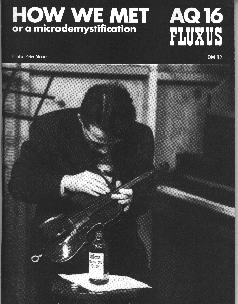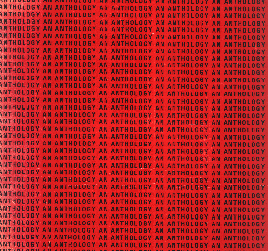FLUXUS
 An extensive amount of
material has been written about FLUXUS in recent years [1] and a Web
site is also available. The history of this movement has several alternate
versions, which include a group of New York art students in the fifties
experimenting with chance techniques and resurrecting the past traditions of
such experiments. Many of them were involved with John Cage's Experimental
Music Class held The New School for Social Research in Greenwich Village
1958-1960. Besides the students, Cage also invited performance poets and
artists who were doing work which he found interesting to participate in the
classes. Such people as Jackson MacLow, George Brecht, Toshi Ichiyanagi, Al
Hanson, and Allen Kaprow were invited.
An extensive amount of
material has been written about FLUXUS in recent years [1] and a Web
site is also available. The history of this movement has several alternate
versions, which include a group of New York art students in the fifties
experimenting with chance techniques and resurrecting the past traditions of
such experiments. Many of them were involved with John Cage's Experimental
Music Class held The New School for Social Research in Greenwich Village
1958-1960. Besides the students, Cage also invited performance poets and
artists who were doing work which he found interesting to participate in the
classes. Such people as Jackson MacLow, George Brecht, Toshi Ichiyanagi, Al
Hanson, and Allen Kaprow were invited.
Many of them continued the course at composer's Richard
Maxfield's house as an electronic music course after Cage ended the course. La
Monte Young came to New York from California to enroll in it as part of his
graduate studies. Also, Terry Riley, Terry Jennings, and Dennis Johnson
participated in the course, and together the originated what they then called
'static music' which eventually became known as minimal music.
Polymath poet/composer/theorist/ playwright Dick Higgins has
said of early FLUXUS:
The principle ideas we came to share, mainly
through Cage, were derived from Zen Buddhism, the I Ching, Erik Satie, and
Marcel Duchamp... Many also favored the 'time structure' or 'temporal collage'
method of composing musical and other temporal artworks, such as poems, plays,
dances, happenings, and simultaneities.
From the composer Erik Satie they got through Cage a style
of working which was characterized by the abrupt juxtaposition of
contrasting and often mutually disparate passages without transitions between
them. Performance artist Henry Flynt, described their work as 'Concept Art'
in which the material which made up their art were concepts: Since
'concepts' are closely bound up with language, concept art is a kind of art of
which the material is language.
FLUXUS is also an invention of George Maciunas graphic
artist, gallery director and small time entrepreneur. In 1960, La Monte Young
had been asked to guest-edit an issue of a literary journal, Beatitude East,
and it was to include 'concept art' and anything else he thought was
important. One thing lead to another and the collection became
 AN ANTHOLOGY of chance operations concept art
anti-art indeterminacy improvisation meaningless work natural disasters plans
of action stories diagrams Music poetry essays dance constructions mathematics
compositions, BY GEORGE BRECHT, CLAUS BREMER, EARLE BROWN, JOSEPH BYRD,
JOHN CAGE, DAVID DEGENER, WALTER DE MARIA, HENRY FLYNT, YOKO ONO, DICK HIGGINS,
TOSHI ICHIYANAGI, TERRY JENNINGS, DENNIS, DING DONG, RAY JOHNSON, JACKSON MAC
LOW, RICHARD MAXFIELD, ROBERT MORRIS, SIMONE MORRIS, NAM JUNE PAIK, TERRY
RILEY, DITER ROT, JAMES WARING, EMMETT WILLIAMS, CHRISTIAN WOLFF, LA MONTE
YOUNG/LA MONTE YOUNG - EDITOR/GEORGE MACIUNAS - DESIGNER.
AN ANTHOLOGY of chance operations concept art
anti-art indeterminacy improvisation meaningless work natural disasters plans
of action stories diagrams Music poetry essays dance constructions mathematics
compositions, BY GEORGE BRECHT, CLAUS BREMER, EARLE BROWN, JOSEPH BYRD,
JOHN CAGE, DAVID DEGENER, WALTER DE MARIA, HENRY FLYNT, YOKO ONO, DICK HIGGINS,
TOSHI ICHIYANAGI, TERRY JENNINGS, DENNIS, DING DONG, RAY JOHNSON, JACKSON MAC
LOW, RICHARD MAXFIELD, ROBERT MORRIS, SIMONE MORRIS, NAM JUNE PAIK, TERRY
RILEY, DITER ROT, JAMES WARING, EMMETT WILLIAMS, CHRISTIAN WOLFF, LA MONTE
YOUNG/LA MONTE YOUNG - EDITOR/GEORGE MACIUNAS - DESIGNER.
Maciunas supplied the paper, design, and
some money for publishing of the anthology which contained a more or less
arbitrary association of New York avant garde artists at that time. By the end
of 1961 before the anthology was completed (it was finally published in 1963 by
Jackson MacLow and La Monte Young), Maciunas had moved to Germany to escape his
creditors. From there, he continued his contact with the New York artists and
sent out announcements about a series of "yearbooks" of artists works
under the title of FLUXUS [2]. The
"yearbooks" eventually became the FLUXUS "newspaper" V
TRE. Maciunas arranged a series of concerts starting in 1962 bringing many
of the New York artists whose work had been selected for AN ANTHOLOGY to come
to Europe and performing with such avant-gardists there as Joseph Beuys of
Germany and Bengt af Klintberg of Sweden. Even though who and who was not in
FLUXUS at any specific moment was dependent upon Maciunas' somewhat volatile
mood, these European concerts provided a great deal of cross-cultural influence
within the international community of experimental artists of that time. The
FLUXUS concerts at Fylkingen were particularly influential as a precursor to
text-sound composition [3]. Their activities also had
a significant influence on a number of other poets working with sound in Europe
such as Bernard Heidsieck in France and Gerhard Rühm in Germany.
Notes and References:
1. There is a detailed essay by Jackson
MacLow about the beginnings of FLUXUS, "Wie George Maciunas die New Yorker
Avantgarde kennenlernte" in the catalog 1962 WiesbadenFLUXUX 1982
(Berlin: Harlekin Art, 1983) which is also printed in English.
2. To purge, A fluid discharge, esp.
an excessive discharge, from the bowels or other part. A continuous moving on
or passing, as of a flowing stream, a stream; copious flow, the setting of the
tide toward the shore, Any substance or mixture, as silicates, limestone and
fluorite, used to provide fusion, esp. the fusion of metals or minerals.
Maciunas' definition from MacLow, p. 116.
3. In Sweden, the text-sound
composers-to-be took part in various fluxus and happening like activities from
about 1960 on. Fylkingen was one of the focal points, and it was there that
Lars-Gunnar Bodin organized Sweden's first major happening, while Bengt af
Klintberg put on a number of events in which Sten Hanson and Åke Hodell
participated. From Sten Hanson's "Text-sound composition during the
sixties: The Evolution of a Genre" in Literally Speaking edited by
Teddy Hultberg (Sweden: Bo Ejeby Edition, 1993)

Last Modified 20 January 1998
 An extensive amount of
material has been written about FLUXUS in recent years [1] and a Web
site is also available. The history of this movement has several alternate
versions, which include a group of New York art students in the fifties
experimenting with chance techniques and resurrecting the past traditions of
such experiments. Many of them were involved with John Cage's Experimental
Music Class held The New School for Social Research in Greenwich Village
1958-1960. Besides the students, Cage also invited performance poets and
artists who were doing work which he found interesting to participate in the
classes. Such people as Jackson MacLow, George Brecht, Toshi Ichiyanagi, Al
Hanson, and Allen Kaprow were invited.
An extensive amount of
material has been written about FLUXUS in recent years [1] and a Web
site is also available. The history of this movement has several alternate
versions, which include a group of New York art students in the fifties
experimenting with chance techniques and resurrecting the past traditions of
such experiments. Many of them were involved with John Cage's Experimental
Music Class held The New School for Social Research in Greenwich Village
1958-1960. Besides the students, Cage also invited performance poets and
artists who were doing work which he found interesting to participate in the
classes. Such people as Jackson MacLow, George Brecht, Toshi Ichiyanagi, Al
Hanson, and Allen Kaprow were invited. AN ANTHOLOGY of chance operations concept art
anti-art indeterminacy improvisation meaningless work natural disasters plans
of action stories diagrams Music poetry essays dance constructions mathematics
compositions, BY GEORGE BRECHT, CLAUS BREMER, EARLE BROWN, JOSEPH BYRD,
JOHN CAGE, DAVID DEGENER, WALTER DE MARIA, HENRY FLYNT, YOKO ONO, DICK HIGGINS,
TOSHI ICHIYANAGI, TERRY JENNINGS, DENNIS, DING DONG, RAY JOHNSON, JACKSON MAC
LOW, RICHARD MAXFIELD, ROBERT MORRIS, SIMONE MORRIS, NAM JUNE PAIK, TERRY
RILEY, DITER ROT, JAMES WARING, EMMETT WILLIAMS, CHRISTIAN WOLFF, LA MONTE
YOUNG/LA MONTE YOUNG - EDITOR/GEORGE MACIUNAS - DESIGNER.
AN ANTHOLOGY of chance operations concept art
anti-art indeterminacy improvisation meaningless work natural disasters plans
of action stories diagrams Music poetry essays dance constructions mathematics
compositions, BY GEORGE BRECHT, CLAUS BREMER, EARLE BROWN, JOSEPH BYRD,
JOHN CAGE, DAVID DEGENER, WALTER DE MARIA, HENRY FLYNT, YOKO ONO, DICK HIGGINS,
TOSHI ICHIYANAGI, TERRY JENNINGS, DENNIS, DING DONG, RAY JOHNSON, JACKSON MAC
LOW, RICHARD MAXFIELD, ROBERT MORRIS, SIMONE MORRIS, NAM JUNE PAIK, TERRY
RILEY, DITER ROT, JAMES WARING, EMMETT WILLIAMS, CHRISTIAN WOLFF, LA MONTE
YOUNG/LA MONTE YOUNG - EDITOR/GEORGE MACIUNAS - DESIGNER.